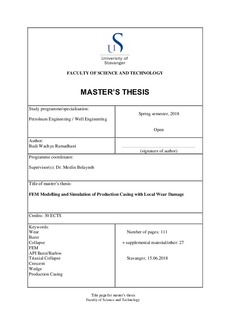| dc.contributor.advisor | Belayneh, Mesfin | |
| dc.contributor.author | Ramadhani, Budi Wachyu | |
| dc.date.accessioned | 2018-10-30T14:53:03Z | |
| dc.date.available | 2018-10-30T14:53:03Z | |
| dc.date.issued | 2018-06 | |
| dc.identifier.uri | http://hdl.handle.net/11250/2570231 | |
| dc.description | Master's thesis in Petroleum engineering | nb_NO |
| dc.description.abstract | Field data show that casing and production tubing experiences wear on both the internal and external parts of the tubular. The main mechanisms of the wear are the mechanical friction between drill string and casing, hydraulics, erosion, and corrosion. The occurrence of wear on the production casing results in reduced burst and collapse strength.
The API Burst/Barlow and triaxial collapse models are commonly used to estimate the de-rated burst and collapse strength of the production casing. These analytical models are applied by removing the damaged part of the tubular.
The applicability of the API Burst/Barlow and triaxial collapse models in the case of local wear on the production casing is examined in this thesis by employing Finite Element Method (FEM) analysis. Several local wear model scenarios are simulated. The results of these simulations show that the API Burst/Barlow and triaxial collapse models are not suitable for locally worn production casing. Specifically, the results from FEM analysis are significantly lower than the API Burst/Barlow and triaxial collapse model results. For instance, the results of the FEM analysis show that
• For undamaged and uniform wall cylinder, the analytical models are nearly the same as the FEM simulation result.
• For single crescent-shaped local damage, as the wear depth varies from 0% to 45% of the wall thickness, the API Burst/Barlow model over-predicts the de-rated burst pressure by 0% to 52% as compared with the FEM model.
• For double crescent local damage, as the wear depth varies from 0% to 45% of the wall thickness, the API Burst/Barlow model over-predicts the de-rated burst pressure by 0% to 55% as compared with the FEM model.
• The size, shape, and number of damages effect the magnitude of the de-rated pressure. | nb_NO |
| dc.language.iso | eng | nb_NO |
| dc.publisher | University of Stavanger, Norway | nb_NO |
| dc.relation.ispartofseries | Masteroppgave/UIS-TN-IEP/2018; | |
| dc.rights | Navngivelse 4.0 Internasjonal | * |
| dc.rights.uri | http://creativecommons.org/licenses/by/4.0/deed.no | * |
| dc.subject | petroleum technology | nb_NO |
| dc.subject | petroleumsteknologi | nb_NO |
| dc.subject | brønnteknologi | nb_NO |
| dc.title | FEM Modelling and Simulation of Production Casing with Local Wear Damage | nb_NO |
| dc.type | Master thesis | nb_NO |
| dc.subject.nsi | VDP::Teknologi: 500::Berg‑ og petroleumsfag: 510::Petroleumsteknologi: 512 | nb_NO |

